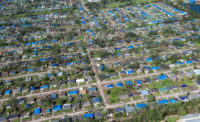Hurricane Delta brought more flooding than wind, but teams surveying Louisiana and Texas so far are reporting less damage to infrastructure and facilities than what they saw after Hurricane Laura just a few weeks ago.
With back-to-back hurricanes, teams are assessing the big-picture impact of two storms in a short amount of time. “You can’t look at Delta without Laura,” says Erika Walter, spokeswoman for the Pelican chapter of the Associated Buliders and Contractors. “A lot of the Lake Charles area was still bleeding when Delta came, and that just picked the scab and made it worse.”
Delta made landfall Friday evening in Creole, La., as a Category 2 storm, just six weeks after Laura came on shore about a dozen miles away as a Category 4 hurricane.
Walter says it helped that contractors have had storm protocols in place for weeks, on top of COVID-19 precautions they’ve had to take for the past six months. “I think our contractors did shine in these areas because they’re used to the last-minute changes a hurricane can throw into the equation of a job site,” she says.
Power Grid Mostly Intact
As of Monday morning, Entergy Corp. had restored power to over three-fourths of its 493,375 customers in Louisiana, Texas and Mississippi who had lost power at the peak of Hurricane Delta.
Compared to the catastrophic damages of Hurricane Laura on Aug. 27, Delta’s impact on the region’s power grid appears to be far less severe, the utility reported Monday morning. Transmission and distribution systems in southeast Louisiana had to undergo a full-scale reconstruction that left many without power for weeks.
“Although Hurricane Delta caused outages to the transmission system in southwest Louisiana, initial assessments indicate minimal transmission damage, which will allow for facilities to be restored much more quickly than following Hurricane Laura,” Entergy spokesman Jerry Nappi said in a statement.
Delta knocked out service for 162 transmission lines and 215 substations. As of Monday morning, there were 176 substations and 107 lines back in service by Monday morning.
Entergy rebuilt most of the transmission system after Laura, and the utility reports that Delta’s impact to the ongoing restoration of the remaining facilities appears minimal.
Using drones, airboats, helicopters, and on-ground surveyors, Entergy on Monday continued its regional damage assessments, which the utility says could take up to three days.
Flooding for Industrial Plants
Water was a bigger issue than wind for industrial plants in southwest Louisiana industrial plants over the weekend, says Jim Rock, executive director of the Lake Area Industry Alliance.
“For anything that withstood the 150 mph winds of Laura, the 100 mph winds from Delta didn’t impact it,” Rock says.
Flooding was reported at some industrial plants, including the W.R. Grace & Co. refining catalysts manufacturing facility in Lake Charles.
Rock did not know the extent of the flooding, but said all of the plants are designed and constructed to withstand high and low tides, and that essential equipment is elevated.
Corps, Airport Take Stock
U.S. Army Corps of Engineers spokesman Ricky Boyett says the Corps is still surveying damages, but that most of the Corps’ flood control structures appear to be in good shape. “Compared to Laura, everything we have fared well,” he says.
Working with the Federal Emergency Management Agency, the Corps has also reactivated Operation Blue Roof to install blue tarps in southwest Louisiana parishes.
Further east in Louisiana, Delta’s winds did little damage to the Lafayette Regional Airport, where the construction of a new $150 million terminal is under way.
Airport executive director Steven Picou said the new terminal sustained some minor roof damage, but no water entered the building. Some hangars on the existing terminal also received roof damage.
“We were very fortunate and came out of this pretty unscathed,” he says.



Post a comment to this article
Report Abusive Comment